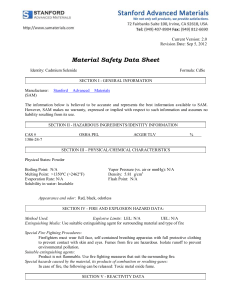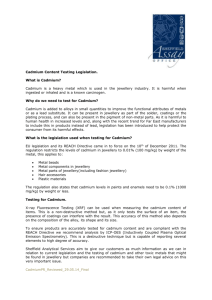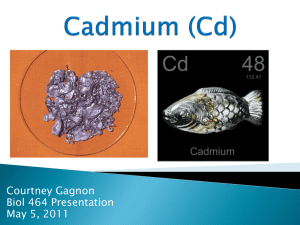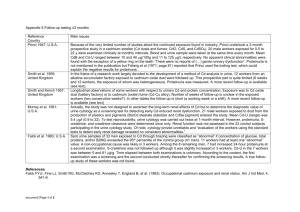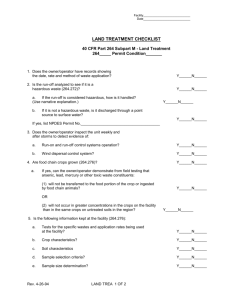26-114-1-RV
advertisement
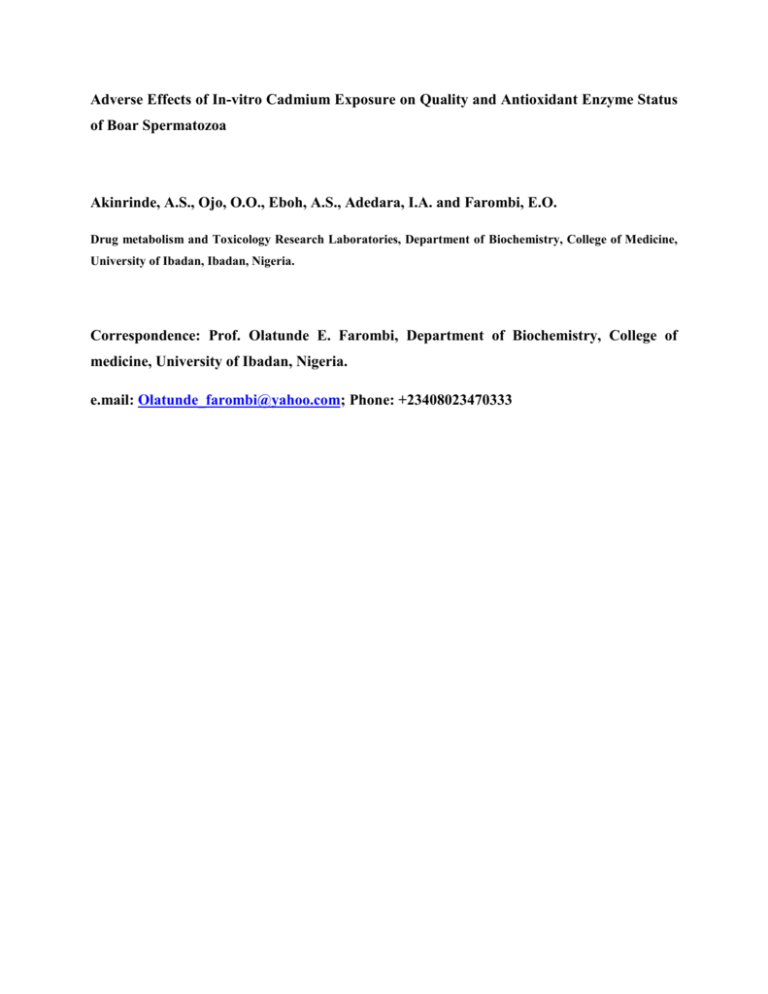
Adverse Effects of In-vitro Cadmium Exposure on Quality and Antioxidant Enzyme Status of Boar Spermatozoa Akinrinde, A.S., Ojo, O.O., Eboh, A.S., Adedara, I.A. and Farombi, E.O. Drug metabolism and Toxicology Research Laboratories, Department of Biochemistry, College of Medicine, University of Ibadan, Ibadan, Nigeria. Correspondence: Prof. Olatunde E. Farombi, Department of Biochemistry, College of medicine, University of Ibadan, Nigeria. e.mail: Olatunde_farombi@yahoo.com; Phone: +23408023470333 ABSTRACT This study was aimed to evaluate the reproductive toxicity of cadmium chloride (CdCl2. 2.5H2O) in Boar spermatozoa in vitro. Boar spermatozoa obtained from the caudal epididymis of freshly slaughtered boars and dispersed in semen incubation medium (containing tris-hydroxymethylaminomethane, citric acid and fructose) were incubated at four different concentrations (0, 0.5, 1.0 and 2.0mM) for 3 hours at 37OC. Sperm viability, motility and percentage of abnormal spermatozoa were assessed by microscopy every one hour during the 3–hour incubation period, using aliquots from the incubated samples. Samples thus treated with cadmium chloride were centrifuged and the supernatant was used in the assessment of biochemical parameters of oxidative stress including hydrogen peroxide (H2O2), reduced glutathione (GSH) and Lipid peroxidation. The activities of antioxidant enzymes, catalase (CAT), superoxide dismutase (SOD), Glutathione peroxidase (GPX) as well as transaminases (ALT and AST) and alkaline phosphatase (ALP) were also assessed. The percentage of motile and viable spermatozoa decreased significantly (p<0.05) after exposure of spermatozoa to CdCl2 in a concentration- and time-dependent manner. Cadmium significantly increased (p<0.05) the levels of H2O2 and malondialdehyde (MDA) in the spermatozoa with significant reductions (p<0.05) in the activities of SOD, GPX, and CAT. Slight but insignificant increase in GSH concentration was accompanied with a slight increase in GST activity. ALT, AST and ALP activities were differentially modified. The results of this study revealed that cadmium chloride caused reductions in sperm motility and viability, increases in oxidative stress and impairment of antioxidant enzyme activities. Keywords: Cadmium chloride, boar, spermatozoa, antioxidant, toxicity INTRODUCTION Infertility, a reduced or complete loss of capacity to reproduce, can be caused by several environmental factors, including heavy metals (Hodgson, 2004). Earlier studies have suggested that at least half of the cases of male infertility of unknown etiology may be attributable to various environmental and occupational exposures to toxic metals (Steeno and Pangkahila, 1984; Gagnon, 1988 Colban et al, 1993). Cadmium is a widespread industrial and environmental pollutant, arising primarily from battery, electroplating, pigment, plastic and fertilizer industries (Waisberg, 2003; Thompson and Bannigan, 2008). In several species, long-term exposure to cadmium produces organ damage or functional deficiency (Sharara et al, 1998). Reports indicate that both the male and female reproductive systems are susceptible to cadmium intoxication resulting in decreased fertility (Saygi et al, 1991; Lymperopoulos et al, 2000). Cadmium naturally occurs in the earth crust combined with other elements including oxygen, sulphur, chloride and carbon (Ige et al, 2012). Heavy metal contamination of soil is believed pose risks and hazards to humans and the ecosystem through direct ingestion or contact with contaminated soil, the food chain (soil-plant-human or soil-plant-animal-human), drinking of contaminated ground water, reduction in food quality (safety and marketability) via phytotoxicity, etc. (McLaughlin et al, 2000; Ling et al, 2007). Soils may become contaminated by the accumulation of heavy metals and metalloids through emissions from the rapidly expanding industrial areas, mine tailings, disposal of high metal wastes, leaded gasoline and paints, land application of fertilizers, animal manures, sewage sludge, pesticides, wastewater irrigation, coal combustion residues, spillage of petrochemicals, and atmospheric deposition (Khan et al, 2008; Zhang et al, 2010). The main mechanism of cellular toxicity by cadmium appears to be the generation of reactive oxygen species. Several studies have demonstrated that cadmium stimulates free radical production, resulting in oxidative deterioration of lipids, proteins and DNA (Manca et al, 1991; Shen and Sangiah, 1995, Shaikh et al, 1999, Thevenod et al, 2000; Almazan et al, 2000). It is thought that cadmium itself is unable to generate free radicals directly but indirect generation of various radicals involving the superoxide radical, hydroxyl radical and nitric oxide has been reported (Galan et al, 2001). Watanabe (2003) has confirmed the generation of the non-radical, Hydrogen peroxide, due to cadmium exposure which itself may be a significant source of radicals via Fenton Chemistry. Moreover, cadmium is believed to attach to sulfhydryl groups of enzymes involved in antioxidant mechanisms, such as superoxide dismutase, peroxidase and catalase, thus inhibiting their activities (Xiao et al, 2002; Bertin and Averbeek, 2006). It is also thought that cadmium forms Cd-selenium complexes in the active centre of glutathione peroxidase, inhibiting the activity of this enzymic antioxidant (Gambhir and Nath, 1992). Lipid peroxidation is a very significant consequence of oxidative stress induced by generation of reactive oxygen species. The process has been associated with morphological abnormalities, decreased sperm motility and viability all of which impairs the ability of spermatozoa to fertilize the ovum (Griveau and Le Lannou, 1997). Previous studies have investigated the testicular and/or spermatozoa toxicity of cadmium in different species (Yang et al, 2003; Gil-Guzman et al, 2004; Yousef et al, 2007; Arabi and Mohammadpour, 2006; Leoni et al, 2002).This present work was aimed to determine the effects of cadmium chloride in vitro on boar spermatozoa using three concentrations of cadmium chloride. MATERIALS AND METHODS Chemicals Cadmium chloride (CdCl2. 2.5 H2O), epinephrine, glutathione, 5, 5′-dithio-bis-2-nitrobenzoic acid, hydrogen peroxide, thiobarbituric acid and 1-chloro-2,4-dinitrobenzene (CDNB) were purchased from Sigma Chemical Co. (St. Louis, MO, USA). All other reagents were of analytical grade and were obtained from the British Drug Houses (Poole, Dorset, UK). Collection and incubation of spermatozoa Semen samples used in this study were obtained from the epididymis of freshly slaughtered mature boars collected from the municipal abattoir in Ibadan, Nigeria. The caudal epididymis were excised and cut open with scalpel to release the semen which was extruded and dispersed into semen incubation medium containing tris-(hydroxymethyl)-aminomethane (37.85g/litre), citric acid anhydrous (21.15g/litre) and D (-) fructose (10 g/litre) (Roca et al., 2000). The chemicals were dissolved in 900ml. The pH was adjusted to 7.0 and then made up to 1 litre with distilled water. A 5000µM stock solution of Cadmium chloride was prepared and mixed with the semen incubation medium at 500µM (0.5mM), 1000µM (1.0mM) and 2000µM (2.0mM) concentrations. Sperm samples were then incubated with the different cadmium concentrations for 3 hours at 37oC. Sperm motility assay Sperm motility was assessed by the method described by Zemjanis (1970). The epididymal spermatozoa that were in rapid forward movement (progressive motility) were evaluated microscopically within 2–4 min of their isolation from the cauda epididymis and data were expressed as percentages. Morphological abnormalities and percentage viability assay Aliquots of spermatozoa placed on a slide glass was smeared out with another slide and stained with Wells and Awa’s stain (0.2 g of eosin and 0.6 g of fast green dissolved in distilled water and ethanol in the ratio 2:1) for morphological examination and 1% eosin and 5% nigrosine in 3% sodium citrate dehydrate solution for live/dead ratio according to the method described by Wells & Awa (1970). Biochemical assays The supernatant was collected for the estimation of catalase (CAT) activity using hydrogen peroxide as substrate according to the method of Clairborne (1995). Superoxide dismutase (SOD) was assayed by the method described by Misra and Fridovich (1972). Glutathione S-transferase (GST) was assayed by the method of Habig et al. (1974). Protein concentration was determined by the method of Lowry et al. (1951). Reducedglutathione (GSH) was determined at 412 nm using the method described by Jollow et al. (1974). Hydrogen peroxide generation was assessed by the method of Wolff (1994). Lipid peroxidation was quantified as malondialdehyde (MDA) according to the method described by Farombi et al. (2000) and expressed as micromoles of MDA per gram tissue. Testicular activities of aspartate amino-transferase (AST) and alanine aminotransferase (ALT) according to Reitmann & Frankel (1957) and alkaline phosphatase (ALP) according to Rec Gscc (DGKC) (1972) were all determined using the Randox kit (Randox Laboratories Limited, Crumlin, UK). RESULTS Effects of CdCl2 on spermatozoa quality characteristics in boar spermatozoa incubated in vitro with CdCl2. Fig. 1 shows a significant decline (p<0.05) in motility (%) of boar spermatozoa exposed to CdCl2 at 0, 0.5, 1.0 and 2.0mM and for 0, 1, 2 and 3 hours. The decline in sperm motility was concentration and time-dependent. Spermatozoa were no longer observed to be motile any longer at the end of three hours of incubation with the three different concentrations of CdCl2. The viability (%) of boar spermatozoa was not significantly affected in the first hour of incubation (Fig. 2). However, in the second and third hours, the viability of the spermatozoa was significantly reduced (p<0.05) when compared with the control. The percentage of morphological abnormalities in the incubated sperm samples assessed at the end of 3 hours of incubation revealed a concentration-dependent increase in morphological abnormalities of spermatozoa, when compared to control (Fig. 3). Effects of CdCl2 on antioxidant systems of boar spermatozoa incubated in vitro with CdCl2 Results of the effects of CdCl2 on antioxidant systems in the different samples are presented in Table 1. Levels of reduced glutathione in the spermatozoa were not significantly altered with any of the concentrations of CdCl2 tested when compared with the control. Glutathione S-transferase activity also was not significantly affected when compared to the control values. The activities of Superoxide dismutase, Glutathione peroxidase and Catalase in the spermatozoa were significantly (p<0.05) reduced in the CdCl2-incubated samples compared to the control. This reduction in the activities of these antioxidant enzymes was concentration-dependent. Incubation of boar spermatozoa with CdCl2 caused a significant (p<0.05) increase in the generation of Hydrogen peroxide (Fig. 4) and the concentration of malondialdehyde (Fig. 5) in a concentration-dependent manner. Effects of CdCl2 on activities of aminotransferases and alkaline phosphatase in boar spermatozoa incubated in-vitro with CdCl2 The activities of alanine transaminase was increased significantly (p<0.05) in the sperm samples exposed to CdCl2 in a concentration-dependent manner, when compared to control (Table 2). However, the activities of aspartate transaminase and alkaline phosphatase were significantly (p<0.05) reduced in a concentration-dependent manner (Table 2). 120 100 * Motility (%) 80 * * * * * O HOUR 60 1 HOUR 2 HOURS 40 3 HOURS * 20 * 0 0 CONTROL 0.5mM * 0 1.0mM 0 2.0mM Cadmium concentrations Fig. 1: Effects of different concentrations of CdCl2 on Motility of boar spermatozoa. Each bar represents the mean±s.d. of three replicates. * indicates that values differ significantly from control (p<0.05). 120 Viability (live-dead)(%) 100 * * * 80 * * * * * O HOUR 60 1 HOUR 2 HOURS 40 3 HOURS 20 0 CONTROL 0.5mM 1.0mM 2.0mM Cadmium concentrations Fig. 2: Effects of different concentrations of CdCl2 on Viability of boar spermatozoa. Each bar represents the mean±s.d. of three replicates. * indicates that values differ significantly from control (p<0.05). Morphological abnormalities(%) 18 16 14 12 10 8 6 4 2 0 CONTROL * * 0.5mM 1.0mM * 2.0mM Cadmium concentrations Fig. 3: Effects of different concentrations of CdCl2 on percentage of morphological abnormalities of boar spermatozoa. Each bar represents the mean±s.d. of three replicates. * indicates that values differ significantly from control (p<0.05). Hydrogen peroxide generation (micromle/mg protein) 25 20 * * 0.5mM 1.0mM * 15 10 5 0 CONTROL 2.0mM Cadmium concentrations Fig. 4: Effects of different concentrations of CdCl2 on hydrogen peroxide generation in boar spermatozoa. Each bar represents the mean±s.d. of three replicates. * indicates that values differ significantly from control (p<0.05). Malondialdehyde concentration (micromole/mg protein) 2.5 * 2 * 1.5 * 1 0.5 0 CONTROL 0.5mM 1.0mM 2.0mM Cadmium concentrations Fig. 5: Effects of different concentrations of CdCl2 on Malondialdehyde (MDA) concentration of boar spermatozoa. Each bar represents the mean±s.d. of three replicates. * indicates that values differ significantly from control (p<0.05). Table 1: Effects of Cadmium chloride on antioxidant systems of boar spermatozoa incubated with cadmium chloride in vitro CONTROL 0.5mM 1.0mM 2.0mM GSH 12.85±1.68 11.25±0.91 12.78±1.15 12.85±0.24 GPX 13.15±2.47 13.65±0.83 8.98±1.48* 7.76±0.59* GST 1.08±0.29 1.07±0.07 1.60±0.42 1.60±0.04* SOD 0.17±0.03 0.12±0.01* 0.08±0.05* 0.01±0.03* CAT 70.43±5.31 67.67±0.50 57.08±3.12* 52.26±1.51* Data are expressed as mean±standard deviation. * indicates values that differ significantly from control (p<0.05). GSH: Reduced glutathione; GPX: Glutathione peroxidase; GST: Glutathione S-transferase; SOD: Superoxide dismutase; GSH (micromole per g tissue) CAT: catalase; GPX activity (units per mg protein); GST activity (micromole CDNB-GSH complex formed per minute per mg protein); SOD (units per mg protein), CAT (micromole H2O2 consumed per minute per mg protein). Table 2: Effects of Cadmium chloride on transaminases and alkaline phosphatase in boar spermatozoa incubated with cadmium chloride in vitro. CONTROL 0.5mM 1.0mM 2.0mM ALT 48.87±0.74 54.29±0.82* 53.63±2.60* 55.30±0.91* AST 15.99±0.30 13.35±0.36* 13.13±0.53* 12.64±0.96* ALP 700.43±5.31 239.81±38.42* 141.07±10.13* 85.26±1.51* Data are expressed as mean±standard deviation in U/L. * indicates values that differ significantly from control (p<0.05). ALT: alanine transaminase; AST; aspartate transaminase; ALP: alkaline phosphatase. DISCUSSION Cadmium is known to exert adverse effects on reproductive structures and functions directly at the testicular level or by altering post-testicular events such as sperm progress motility and/or viability, all of which may result in infertility (Akinloye et al, 2006). In this study, exposure of rats to Cadmium chloride resulted in decreased sperm motility, viability with increased sperm abnormalities. In vitro studies performed by Leoni et al (2002) showed that the viability of ram spermatozoa was significantly affected by exposure to 2 and 20µM cadmium. The decrease in sperm motility may be due to the effects of cadmium on microtubules. Previous studies suggest that cadmium inhibits microtubule sliding in bovine sperm (Kanous, 1993). Microtubule sliding is the basis of flagella motion that propels the spermatozoa in progressive linear motion. Moreover, other studies also showed that cadmium inhibits microtubule assembly in pig (Brunner et al, 1991) and bull brain (Wallin and Hartley-Asp, 1993). In addition, spermatozoa being uniquely rich in polyunsaturated fatty acids (Vernet et al, 2004) are very susceptible to oxidative insult. Generally, the generation of reactive oxygen species and consequent oxidative damage to macromolecules as a mechanism of Cadmium toxicity has been established in many investigations (Shaikh et al, 1999; Stohs et al, 2000). Oxidative stress is known to play a crucial role in the aetiology of defective sperm function via mechanisms involving the induction of peroxidative damage to the plasma membrane (Sharma and Agarwal, 1996; Agarwal and Saleh, 2002; Vernet et al, 2004). Increased sperm lipid peroxidation has been shown to impede sperm progressive motility and increase percent total sperm abnormalities as well as cause a dramatic loss in the fertilizing potential of sperm (Sharma and Agarwal, 1996; El-Demerdash et al, 2004). In this study, the concentration of malondialdehyde as an index of lipid peroxidation was significantly increased, implying the generation of reactive oxygen species. This effect is substantiated by the increased levels of Hydrogen peroxide observed. According to Waisberg et al, 2003, cadmium induces oxidative stress due to reactive oxygen species (ROS) accumulation, mostly superoxide anion radical (O2•), hydrogen peroxide (H2O2) and hydroxyl radical (•OH). The extent to which oxidative damage affects spermatozoa highly depends on their antioxidant defense status (Sikka, 2001). The activities of antioxidant enzymes in spermatozoa exposed to cadmium in this study showed significant decreases in SOD, CAT and GPx, while GSH levels and GST activities were not significantly altered. Cadmium is known to bind to cysteine in GSH resulting in the inactivation of GPX which therefore, fails to metabolize hydrogen peroxide to water. Evidence from other investigations also indicated that cadmium interacts with Selenium and disrupts GPx activity (Ursini, 1995). GSH functions as a free radical scavenger, a co-substrate for GPx activity and a co-factor for many enzymes (Sies, 1999). It is known that the level of GSH decreases in tissues exposed to cadmium, and a complex is formed between cadmium and GSH via a reaction catalyzed by GST (Singhal et al, 1987). Further spermiotoxic effects of cadmium obtained in this study include the reductions in the activities of AST and ALP. This finding is similar to the reports of El-Demerdash et al (2004) who observed decreased ALP levels in the testes. It was believed that the decrease in ALP activity may be due to Cd-induced disturbances in the balance between synthesis and degradation of the enzyme (Rana et al., 1996). Moreover, Cd is thought to inhibit ALP by competing with and displacing zinc, which is an essential part for the enzyme activity (Suzuki et al., 1989). The activity of ALT evaluated in boar sperm showed a concentration-dependent increase with exposure to cadmium. In conclusion, the results suggest that cadmium stimulated oxidative damage in boar spermatozoa as indicated by increased lipid peroxidation, hydrogen peroxide generation and reduction in the activities of anti-oxidative enzymes, CAT, SOD and GPX. The accompanying reductions in sperm motility, viability and increased morphological abnormalities in the spermatozoa all indicate adverse effects promoted by cadmium. The metal therefore, may contribute to reproductive toxicity in the boar. REFERENCES Almazan G, Liu HN, Khorchid A, Sundarajan S, Martinez AK, Bermudez S (2000). Exposure of developing oligodendrocytes to cadmium causes HSP72 induction, free radical generation reduction in glutathione levels and cell death. Free radic. Biol. Med. 29: 858-869 Bertin G, Averbeck D (2006). Cadmium cellular effects, modifications of biomolecules, modulation of DNA repair and genotoxic consequences (a review). Biochimie. 88: 1549-1559. Colborn T, VomSaal FS, Soto AM (1993). Developmental effects of endocrine disrupting chemicals in wildlife and humans. Environ. Health Perspect. 101: 378-84. Clairborne A (1995) Catalase activity. In: Handbook of Methods for Oxygen Radical Research. Greewald AR (ed.). CRC Press, Boca Raton, FL, pp 237–242. El-Demerdash FM, Yousef MI, Kedwany FS, Bahadadi HH (2004). Cadmium-induced changes in lipid peroxidation, blood hematology, biochemicalparameters and semen quality of male rats: protective role of vitamin E and b-carotene. Food Chem. Toxicol. 42: 1563–1571 Farombi EO, Tahnteng JG, Agboola AO, Nwankwo JO, Emerole GO (2000) Chemoprevention of 2-acetylaminofluo-rene-induced hepatotoxicity and lipid peroxidation in rats by kolaviron-a Garcinia kolaseed extract.Food Chem Toxicol 38:535–541. Gagnon C (1988). The role of environmental toxins in unexplained male infertility.Sem. Reprod. Endocrinol. 6: 369-376. Galan A, Garcia-Bermejo L, Troyano A, Vilaboa NE, Fernadez C, de Blas E, Aller P (2001). Europ. J. Cell. Biol. 80: 312-320 Gambhir J, Nath R (1992). Effect of cadmium on tissue glutathione and glutathione peroxidase in rats: influence of selenium supplementation. Indian J. Exp. Biol. 30: 597-601. Gil-Guzman E, Ollero M, Lopez MC, Sharma RK, Alvarez JG (2001). Differential production of reactive oxygen species by subsets of human spermatozoa at different stages of maturation. Hum. Reprod. 16: 1922-1930. Habig WH, Pabst MJ, Jakoby WB (1974) Glutathione S- transferase. The first enzymatic step in mercapturic acid formation. J Biol Chem 249:7130–7139. Hodgson E (2004). A Textbook of Modern Toxicology.Third Edition, John Wiley and Sons, Inc. Ige SF, Olaleye SB, Akhigbe RE, Oyekunle OA, Udoh US (2012). Testicular toxicity and sperm quality following cadmium exposure in rats: ameliorative potentials of Allium cepa. J. Hum. Rep. Sci. 5(1):37-42. Jollow DJ, Mitchell JR, Zampaglione N, Gillette JR (1974). Bromobenzene induced liver necrosis: protective role of glutathione and evidence for 3, 4 bromobenzene oxide as the hepatotoxic metabolite. Pharmacology11 (3): 151–169 Khan S, Cao Q, Zheng YM, Huang YZ, Zhu YG (2008). Health risks of heavy metals in contaminated soils and food crops irrigated with wastewater in Beijing, China. Environmental Pollution. 152(3): 686–692. Leoni G, Bogliolo L, Deiana G, Berlinguer F, Rosati I, Pintus PP, et al. (2002). Influence of cadmium exposure on in vitro ovine gamete dysfunction. Reprod Toxicol. 16:371–7. Ling W, Shen Q, Gao Y, Gu X, Yang Z (2007). Use of bentonite to control the release of copper from contaminated soils. Australian Journal of Soil Research 45(8): 618–623. Lowry OH, Rosenbrough NJ, Farr AL, Randall RJ (1951) Protein measurement with Folin phenol reagent.J Biol Chem 193:265–275. Lymberopoulous AG, Kotsaki-Kovatsi AV, Taylor A, Papaioannou N, Brikas P (2000). Effects of cadmium chloride administration on the macroscopic and microscopic characteristics of ejaculates from chios ram-lambs. Theriogen. 54: 1145-57. Manca D, Richard A, Trottier B, Chevallier G (1991). Studies on lipid peroxidation in rat tissues following administration of cadmium chloride. Toxicology 67: 303-323 McLaughlin MJ, Zarcinas BA, Stevens DP, Cook N (2000). Soil testing for heavy metals. Communications in Soil Science and Plant Analysis 31(11): 1661–1700. Misra HP, Fridovich I, (1972). The role of superoxide anion in the autooxidation of epinephrine and a simple assay for superoxide dismutase.Journal of Biological Chemis-try 247(10): 3170– 3175. Mostafa T, Tawadrous G, Edward P, Roaia MM, Amer MK, Kader RA, Aziz A (2006). Effect of smoking on seminal plasma ascorbic acid in infertile and fertile males. Andrologia 38: 221-224. Rec Gscc (DGKC) (1972) Optimised standard colorimetric methods.J Clin Chem Clin Biochem 10:182. Reitmann S, Frankel S (1957) Colorimetric method for the determination of serum transaminase activity.Am J Clin Pathol28:56–68. Rana SV, Rekha S, Seema V (1996). Protective effects of few antioxidants on liver function in rats treated with cadmium and mercury. Indian J. Exp. Biol. 34: 177– 179. Roca J, Martinez S, V’azquez JM, Lucas X, Parrilla I, Martinez EA (2000). Viability and fertility of rabbit spermatozoa diluted in Tris-buffer extenders and stored at 15oC. Anim. Reprod. Sci. 64: 103-112. Saygi S, Deniz G, Kutsal O, Vural N (1991). Chronic effects of cadmium on kidney, liver, testis and fertility of male rats. Biol. Trac. Elem. Res. 31: 209-14. Shaikh ZA, Vu TT, Zaman K (1999). Oxidative stress as a mechanism of chronic cadmiuminduced hepatotoxicity and renal toxicity and protection by antioxidants. Toxicol Appl Pharmacol 154: 256-263 Sharara FI, Seifer DB, Flaw JA (1998). Environmental toxicants and female reproduction. Fert. Ster. 70: 613-22 Shen Y, Sangiah S (1995). Na+-K+ ATPase, glutathione and hydroxyl free radicals in cadmium chloride-induced testicular toxicity in mice. Archives of environmental contamination and Toxicology 27: 174-179 Steeno OA, Pangkahila A (1984). Occupational influences on male fertility and sexuality. Andrologia, 16: 5-22 Suzuki Y, Morita I, Yamane Y, Murota S (1989). Preventive effects of zinc on cadmium-induced inhibition of alkaline phosphatase Pharmacobiodyn. 12: 94–99 activity in osteoblast-like cells, MC3T3-EI. J. Thevenod F, Friedmann JM, Katsen AD, Hauser IA (2000). Upregulation of multidrug resistance p-glycoprotein via nuclear factor-kappa B activation protects kidney proximal tubule cells from cadmium and reactive oxygen species-induced apoptosis. J. Biol. Chem. 275: 1887-1896. Thompson J, Bannigan J (2008). Cadmium: Toxic effects on the reproductive system and the embryo. Reprod. Toxicol.. 25: 304-15. Waisberg M, Joseph P,Hale B, Beyersmann D (2003). Molecular and Cellular mechanisms of cadmium carcinogenesis: a review. Toxicology. 192: 95-117 Watanabe MK, Henmi K, Ogawa K, Suzuki T (2003). Compar. Biochem. Physiol. C. Toxicol. Pharmacol. 134: 227-234. Wells ME, Awa OA (1970) New technique for assessing acrosomal characteristics of spermatozoa.J Dairy Sci 53:227. Wolff SP (1994). Ferrous ion oxidation in the presence of ferric ion indicator xylenol orange for measurement of hydroperoxides. Method Enzymol. 233:182–189. Xiao L, Pimentel DR, Wang J, Singh K, Colucci WS, Sawyer DB (2002). Role of reactive oxygen species and NAD (P) H oxidase in alpha(1)-adrenoceptor signaling in adult rat cardiac myocytes. Am. J. Physiol. Cell Physiol. 282: 926-834. Yang JM, Arnus M, Chen QY, Wu XD, Pang B, Jiang XZ (2003). Reprod. Toxicol. 17: 553-560 Yousef MI, Kamel KI, El-Guendi MI, El-Demerdash FM (2007). An in vitro study on reproductive toxicity of aluminium chloride on rabbit sperm: the protective role of some antioxidants. Toxicology 239: 213-223. Zemjanis R (1970) Collection and evaluation of semen. In: Diagnostic and Therapeutic Technique in Animal Reproduction, 2nd edn. Zemjanis R (ed.). The William and Wilkins Company, Waverly Press Inc., Baltimore, MD, pp 139–153. Zhang, MK, Liu ZY, Wang H (2010). Use ofsingle extraction methods to predict bioavailability of heavy metals in polluted soils to rice. Communications in Soil Science and Plant Analysis, 41(7): 820–831.

